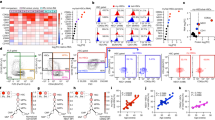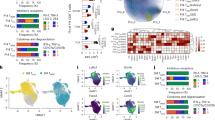Abstract
Acquired immune deficiency syndrome (AIDS) is characterized by opportunistic infections and by ‘opportunistic neoplasms’ (for example, Kaposi's sarcoma)1. Persistent generalized lymphadenopathy (PGL) is epidemiologically associated with AIDS, especially in male homosexuals. A subset of T lymphocytes positive for the CD4 antigen2 (also termed T4 antigen), is depleted in AIDS and PGL patients. A retrovirus found in T-cell cultures from these patients3–5 is strongly implicated in the aetiology of AIDS because of the high frequency of isolation4 and the prevalence of specific antibodies6–8 in the patients. Here we have detected cell-surface receptors for the AIDS retrovirus (human T-cell leukaemia virus-III (HTLV-III) and lymphadenopathy-associated virus-1 (LAV-1) isolates) by testing the susceptibility of cells to infection with pseudotypes of vesicular stomatitis virus bearing retroviral envelope antigens, and by the formation of multinucleated syncytia on mixing virus-producing cells with receptor-bearing cells. Receptors were present only on cells expressing CD4 antigen; among 155 monoclonal antibodies tested, each of the 14 anti-CD4 antibodies inhibited formation of syncytia and blocked pseudotypes. Productive infection of CD4+ cells with HTLV-III or LAV-1 markedly reduced cell-surface expression of CD4. In contrast, receptors for HTLV-I and HTLV-II were not restricted to CD4+ cells, were not blocked by anti-CD4 antibodies; cells productively infected with HTLV-I and HTLV-II expressed surface CD4. Hence, we conclude that the CD4 antigen is an essential and specific component of the receptor for the causative agent of AIDS.
Similar content being viewed by others
Article PDF
References
Pinching, A. J. Clin. exp Immun. 56, 1–13 (1984).
Terhost, C., van Agthoven, A., Reinherz, E. & Schlossman, S. Science 209, 520–521 (1980).
Barré-Sinoussi, F. et al. Science 220, 868–870 (1983).
Gallo, R. C. et al. Science 224, 500–503 (1984).
Popovic, M., Sarngadharan, M. G., Read, E. & Gallo, R. C. Science 224, 497–500 (1984).
Brun-Vezinet, F. et al. Lancet i, 1253–1256 (1984).
Safai, B. et al. Lancet i, 1438–1440 (1984).
Cheingsong-Popov, R. et al. Lancet ii, 477–480 (1984).
Vilmer, E. et al. Lancet i, 753–757 (1984).
Montagnier, L. et al. in Human T-cell Leukemia/Lymphoma Virus (eds Gallo, R. C., Essex, M. & Gross, L.) 363–379 (Cold Spring Harbor Laboratory, New York, 1984).
Schüpbach, J. et al. Science 224, 503–506 (1984).
Arya, S. K. et al. Science 225, 927–980 (1984).
Popovic, M. et al. Proc. natn. Acad. Sci. U.S.A. 80, 5402–5406 (1983).
Chen, I. S. Y., Quan, S. G. & Golde, D. W. Proc. natn. Acad. Sci. U.S.A. 80, 7006–7009 (1983).
Klatzmann, D. et al. Science 225, 59–63 (1984).
Montagnier, L. et al. Science 225, 63–66 (1984).
Clapham, P., Nagy, K., Cheingsong-Popov, R. & Weiss, R. A. Science 222, 1125–1127 (1983).
Hoshino, H., Shimoyama, M., Miwa, M. & Sugimura, T. Proc. natn. Acad. Sci. U.S.A. 80, 7337–7341 (1983).
Nagy, K., Clapham, P., Cheingsong-Popov, R. & Weiss, R. A. Int. J. Cancer 32, 321–328 (1983).
Clapham, P., Nagy, K. & Weiss, R. A. Proc. natn. Acad. Sci. U.S.A. 81, 2886–2889 (1984).
Zavada, J. J. gen. Virol. 15, 183–191 (1972).
Boettiger, D., Love, D. N. & Weiss, R. A. J. Virol. 15, 108–114 (1975).
Weiss, R. A. in Virus Receptors (eds Lonberg-Holm, K. & Philipson, L.) 186–202 (Chapman & Hall, London, 1981).
Thiry, L. et al. J. Virol. 48, 697–708 (1983).
Klatzmann, D. et al. Nature 312, 767–771 (1984).
Gatenby, P. A. et al. J. Immun. 129, 1997–2000 (1982).
Bernard, A. et al. (eds) Leucocyte Typing (Springer, Berlin, 1984).
Meuer, S. C., Schlossman, S. F. & Reinherz, E. L. Proc. natn. Acad. Sci. U.S.A. 79, 4395–4399 (1982).
Biddison, W. E. et al. J. exp. Med. 159, 783–797 (1984).
Nicholson, J. K. A. et al. J. clin. Invest. 73, 191–201 (1984).
Sundström, C. & Nilsson, K. Int. J. Cancer 17, 565–577 (1976).
Wood, G. S., Warner, N. L. & Warnke, R. A. J. Immun. 131, 212–216 (1983).
Moscicki, R. A. et al. J. Immun. 131, 743–748 (1983).
Fingeroth, J. D. et al. Proc. natn. Acad. Sci. U.S.A. 81, 4510–4514 (1984).
Lentz, T. L. et al. Science 215, 182–184 (1982).
Author information
Authors and Affiliations
Rights and permissions
About this article
Cite this article
Dalgleish, A., Beverley, P., Clapham, P. et al. The CD4 (T4) antigen is an essential component of the receptor for the AIDS retrovirus. Nature 312, 763–767 (1984). https://doi.org/10.1038/312763a0
Received:
Accepted:
Issue Date:
DOI: https://doi.org/10.1038/312763a0
This article is cited by
-
Progress in Pathological and Therapeutic Research of HIV-Related Neuropathic Pain
Cellular and Molecular Neurobiology (2023)
-
Optimisation of a TALE nuclease targeting the HIV co-receptor CCR5 for clinical application
Gene Therapy (2021)
-
Defining rules governing recognition and Fc-mediated effector functions to the HIV-1 co-receptor binding site
BMC Biology (2020)
-
Benefits and limitations of humanized mice in HIV persistence studies
Retrovirology (2020)
-
Longitudinal analysis of subtype C envelope tropism for memory CD4+ T cell subsets over the first 3 years of untreated HIV-1 infection
Retrovirology (2020)
Comments
By submitting a comment you agree to abide by our Terms and Community Guidelines. If you find something abusive or that does not comply with our terms or guidelines please flag it as inappropriate.



